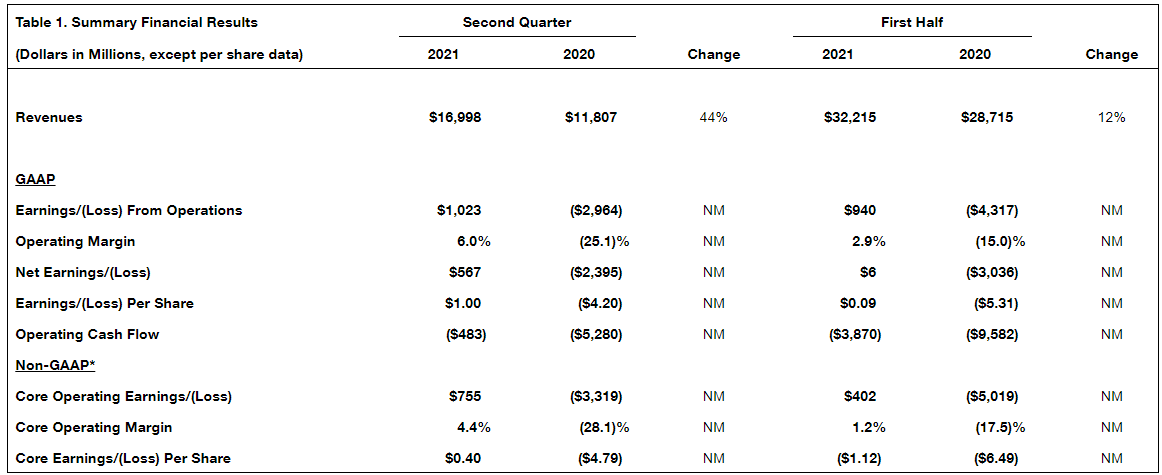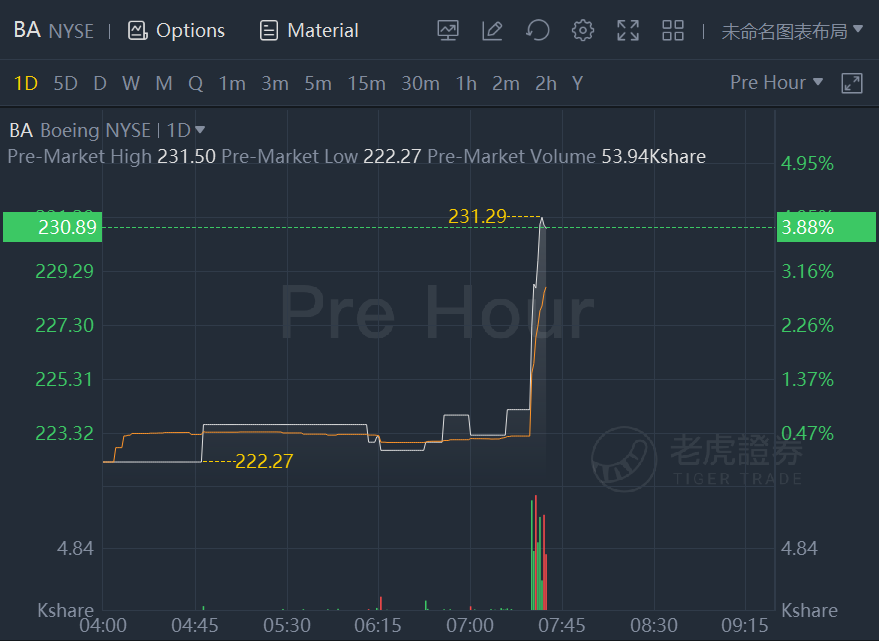- Continued progress on global safe return to service of 737 MAX
- Revenue of $17.0 billion, GAAP earnings per share of $1.00 and core (non-GAAP)* earnings per share of $0.40
- Operating cash flow of ($0.5) billion; cash and marketable securities of $21.3 billion
- Commercial Airplanes backlog grew to $285 billion and added 180 net orders
The Boeing Company [NYSE: BA] reported second-quarter revenue of $17.0 billion, driven by higher commercial airplanes and services volume. GAAP earnings per share of $1.00 and core earnings per share (non-GAAP)* of $0.40 primarily reflects higher commercial volume and lower period costs (Table 1). Boeing recorded operating cash flow of ($0.5) billion.
Boeing shares surged 4% in premarket trading.
"We continued to make important progress in the second quarter as we focus on driving stability across our operations and transforming our business for the future," said Boeing President and Chief Executive Officer David Calhoun. "While our commercial market environment is improving, we're closely monitoring COVID-19 case rates, vaccine distribution and global trade as key indicators for our industry's stability. As we continue to position for a robust recovery, we remain committed to safety and quality, while investing in our people, products and technology. I am proud of our team's resilience and commitment as we work to rebuild trust, improve our performance and deliver for our commercial, defense, space and services customers."
As part of Boeing's ongoing focus on global sustainability, the company published its first integrated Sustainability Report in July. "This was an important step in our continued efforts to reinforce our Environmental, Social, and Governance principles," Calhoun said.



Boeing is continuing to make progress on the global safe return to service of the 737 MAX. Since the FAA's approval to return the 737 MAX to operations in November 2020, Boeing has delivered more than 130 737 MAX aircraft and airlines have returned more than 190 previously grounded airplanes to service. 30 airlines are now operating the 737 MAX, safely flying nearly 95,000 revenue flights totaling more than 218,000 flight hours (as of July 25, 2021). The 737 program is currently producing at a rate of approximately 16 per month and continues to expect to gradually increase production to 31 per month in early 2022 with further gradual increases to correspond with market demand. The company will continue to assess the production rate plan as it monitors the market environment and engages in customer discussions.
As Boeing has previously shared, the company is conducting inspections and rework and continues to engage in detailed discussions with the FAA on verification methodology for 787. In connection with these efforts, the company announced earlier this month that it has identified additional rework that will be required on undelivered 787s. Based on our assessment of the time required to complete this work, Boeing is reprioritizing production resources for a few weeks to support the inspection and rework. As that work is performed, the 787 production rate will temporarily be lower than five per month and will gradually return to that rate. Boeing expects to deliver fewer than half of the 787s currently in inventory this year.
Commercial Airplanes secured orders for 200 737 aircraft for United Airlines, 34 737 aircraft for Southwest Airlines, and a total of 31 freighter aircraft. Commercial Airplanes delivered 79 airplanes during the quarter and backlog included over 4,100 airplanes valued at $285 billion.
margin increased to 13.9 percent, primarily reflecting the absence of a charge on the KC-46A Tanker program as compared to second quarter 2020, as well as a favorable non-US contract adjustment.
During the quarter, Defense, Space & Security secured an award for 14 H-47 extended-range Chinook helicopters for the U.K. Royal Air Force and signed an agreement with the German Ministry of Defense for five P-8A Poseidon aircraft. Defense, Space & Security conducted the first MQ-25 unmanned aerial refueling of a F/A-18 Super Hornet and successfully joined T-7A Red Hawk front and aft sections in under 30 minutes enabled by digital design. Also, the first Core Stage for NASA's Space Launch System began stacking with other Artemis I elements.
Backlog at Defense, Space & Security was $59 billion, of which 32 percent represents orders from customers outside the U.S.
During the quarter, Global Services signed an expanded parts agreement with Turkish Technic and announced a partnership to expand capacity for 737-800 Boeing Converted Freighters. Global Services was also selected to provide P-8A training and sustainment as well as C-17 training to the U.K. Royal Air Force, and was awarded a modification for KC-46A interim contract support for the U.S. Air Force.
Non-GAAP Measures Disclosures
We supplement the reporting of our financial information determined under Generally Accepted Accounting Principles in the United States of America (GAAP) with certain non-GAAP financial information. The non-GAAP financial information presented excludes certain significant items that may not be indicative of, or are unrelated to, results from our ongoing business operations. We believe that these non-GAAP measures provide investors with additional insight into the company's ongoing business performance. These non-GAAP measures should not be considered in isolation or as a substitute for the related GAAP measures, and other companies may define such measures differently. We encourage investors to review our financial statements and publicly-filed reports in their entirety and not to rely on any single financial measure. The following definitions are provided:
Core Operating Earnings, Core Operating Margin and Core Earnings Per Share
Core operating earnings is defined as GAAP earnings from operations excluding the FAS/CAS service cost adjustment.The FAS/CAS service cost adjustmentrepresents the difference between the Financial Accounting Standards (FAS) pension and postretirement service costs calculated under GAAP and costs allocated to the business segments. Core operating margin is defined as core operating earnings expressed as a percentage of revenue. Core earnings per share is defined as GAAP diluted earnings per share excluding the net earnings per share impact of the FAS/CAS service cost adjustmentand Non-operating pension and postretirement expenses. Non-operating pension and postretirement expenses represent the components of net periodic benefit costs other than service cost. Pension costs, comprising service and prior service costs computed in accordance with GAAP are allocated to Commercial Airplanes and BGS businesses supporting commercial customers. Pension costs allocated to BDS and BGS businesses supporting government customers are computed in accordance with U.S. Government Cost Accounting Standards (CAS), which employ different actuarial assumptions and accounting conventions than GAAP. CAS costs are allocable to government contracts. Other postretirement benefit costs are allocated to all business segments based on CAS, which is generally based on benefits paid. Management uses core operating earnings, core operating margin and core earnings per share for purposes of evaluating and forecasting underlying business performance. Management believes these core earnings measures provide investors additional insights into operational performance as they exclude non-service pension and post-retirement costs, which primarily represent costs driven by market factors and costs not allocable to government contracts. A reconciliation between the GAAP and non-GAAP measures is provided on pages 13-14.
Free Cash Flow
Free cash flow is GAAP operating cash flow reduced by capital expenditures for property, plant and equipment. Management believes free cash flow provides investors with an important perspective on the cash available for shareholders, debt repayment, and acquisitions after making the capital investments required to support ongoing business operations and long term value creation. Free cash flow does not represent the residual cash flow available for discretionary expenditures as it excludes certain mandatory expenditures such as repayment of maturing debt. Management uses free cash flow as a measure to assess both business performance and overall liquidity. Table 2 provides a reconciliation of free cash flow to GAAP operating cash flow.

